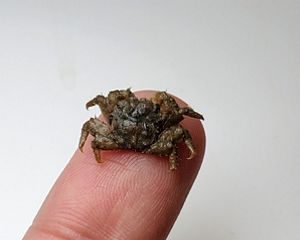
Hong Kong has around 550 bird species, accounting for one-third of the bird species found in China. This is because Hong Kong has a wide range of ideal bird habitats, including wetlands, grasslands, forests and coastal areas. And because Hong Kong lies on the East-Asian Australasian Flyway, many migratory birds stopover in Hong Kong in wintertime during their long journeys.
Around the world, TNC works to protect and restore habitats that are critical to birds and other wildlife, including our mudflat and shellfish reef restoration projects in Pak Nai.
Sparrows, spotted doves, Red-whiskered bulbul are commonly seen around Hong Kong, but other local bird species are not so easy to spot. TNC Spatial Scientist and avid birder Tim Boucher has captured amazing photos of some of Hong Kong’s coolest birds—check out this slideshow of his photos and compare it to your own Hong Kong birding bucket list!

About Tim Boucher:
Tim Boucher is a Senior Conservation Geographer at The Nature Conservancy, in addition to being an enthusiastic birder, hiker and photographer. He has used remote sensing and geographic information science to assess the conditions, protections and threats to natural habitats, having conducted field assessments on six continents.
Black-faced spoonbills
These endangered birds are winter visitors to Hong Kong, a critical stopover point on their migrations across East Asia.
Though their populations are beginning to bounce back, pollution, habitat loss and degradation continue to pose major threats to the species’ survival.
TNC works with partners to protect, clean up and restore Black-faced spoonbill habitats, including places like Deep Bay and Chongming Dongtan in Shanghai.

Chestnut bulbul
Though only found in China, Hong Kong and Vietnam, chestnut bulbul populations appear to be healthy.
Perhaps this is because these songbirds seem quite adaptable and willing to live even in heavily degraded forests.
Since chestnut bulbuls are known for being noisy, you’re likely to hear one before you see it! They are common to see and hear throughout Hong Kong wooded areas.

Stejneger’s stonechat
One of several species of stonechat, Stejneger’s stonechat are native to East Asia and are similar to Siberian stonechat and sometimes regarded as a sub-species of Siberian stonechat.
They are commonly found in Hong Kong in spring, autumn and winter—usually atop things. Their call sounds like “tack tack” – like two stones being slapped against each other.

Eurasian Whimbrel
These migratory birds live in Asia and Europe and winter along the coasts of Africa, Asia and Australia.
Their call sounds like a whistle. They are commonly seen (and heard!) in Hong Kong mudflats during the winter, using their downcurved bills to hunt crabs and other small prey.
TNC’s projects in Pak Nai to protect and restore mudflats and shellfish reefs helps ensure healthy habitats for wildlife and people alike.

Black-capped kingfisher
Black-capped kingfishers are easily recognizable because of their bright coloring: they have black heads, red bills, blueish-purplish backs and white collars.
They are commonly seen in Hong Kong mudflats and wetlands in winter, often atop mangroves as they scan for prey. TNC’s work with the Pak Nai community to protect and restore mudflats and shellfish reefs there helps create safe mudflat and wetland habitat.
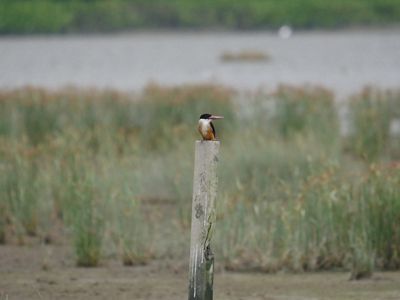
Greater Necklaced Laughingthrush
These beautiful birds with distinctive white stripes around their eyes are Hong Kong residents, but you have to be lucky to spot one: they are known for being shy and difficult to see in the dense forests where they prefer to shelter.

Scarlet Minivet
These Hong Kong residents can be found in the treetops of forests and wooded areas throughout the city. Male scarlet minivets are red with black upper parts, while females are yellow with grey upper parts.

Yellow-Bellied Prinia
Yellow-bellied Prinia are commonly found in Hong Kong in wetlands and reed marshes.
Protecting and restoring coastal areas in places like Deep Bay—such as the work TNC is doing in Pak Nai—helps create healthy habitats for these birds.
They have a pretty little song and long tails.
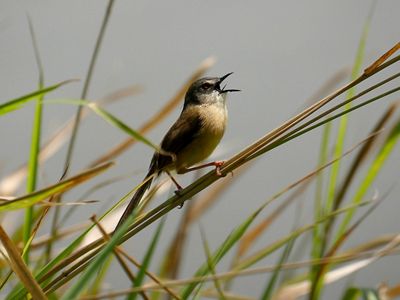
Orange-headed Thrush
While these beautiful birds with distinctive orange heads and bellies are not threatened, their population is decreasing. They visit Hong Kong in winter and can be seen in wooded areas by watchful, quiet seekers: orange-headed thrush are shy and quiet, and not easily noticed.
Their beautiful coloring can also be an unfortunate liability: in some places, its numbers are declining as it has become a popular cage-bird.

Mountain Tailorbird
These tiny songbirds with yellow underparts live in forests.
You have to be lucky to see one: according to the Agriculture, Fisheries and Conservation Department, they are uncommon residents in Hong Kong.
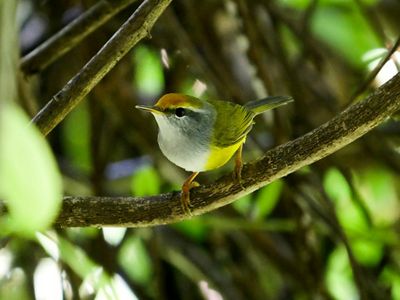
Red-whiskered bulbul
Also known as crested bulbuls, these birds are commonly seen in forests and even gardens around Hong Kong.
Their erect crown feathers and red cheeks make them easy to identify—and quite adorable!
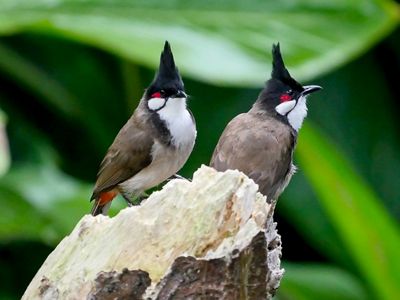
Collared crow
Easily spotted year-round in Hong Kong wetlands, these crows are also easy to identify thanks to their white collars that stand out against otherwise all-black bodies. These birds are only found in China, Hong Kong and Vietnam.
Sadly, collared crow populations seem to be quickly declining due to pesticides and hunting according to research published in Forktail. Hong Kong is one of their two most important homes, and protecting their wetland habitat in Deep Bay may be critical to the species’ survival.

Spotted Redshank
These winter visitors to Hong Kong have long red legs and a black upper bill and red lower bill. They can be found in mudflats where they usually hunt for food.
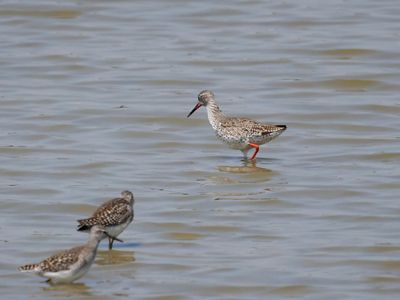
Pied Avocet
These black-and-white waders winter in Hong Kong, where they feed on bugs and crabs in local wetlands and mudflats.
They are easily identified because of their distinctive pattern, as well as their upturned bills and their habit of sweeping their heads from side-to-side when feeding.

Eastern Marsh Harrier
These birds of prey are typically migratory, and hard to miss if you see one flying above Hong Kong marshlands—they are quite large, with a wingspan over one meter!

Habitat loss is the number one threat to the survival of birds and wildlife.
Make a difference
Give NowProtecting and restoring natural habitats—whether Hong Kong’s mudflats, estuaries and shellfish reefs or tropical forests in Indonesia and the Amazon—is absolutely critical to avoid mass extinction.
TNC has protected 52M hectares of land so far, thanks to people just like you. Make a difference for our planet today with a secure, fast one-time or monthly donation. No gift is too small, and gifts over HK$ are tax-deductible.
Bring some fresh air and sunshine into your inbox!
You will receive important news about nature and wildlife, invitations to special events, lots of inspiration and much more!

